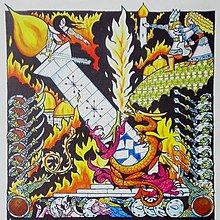Glorfindel
The character and his name, which means "blond" or "golden-haired", were among the first created for what would become part of his Middle-earth legendarium in 1916–17, beginning with the initial draft of The Fall of Gondolin.
The incremental changes made to Glorfindel's character, most notably the introduction of the theme of reincarnation, as part of the ongoing development of Tolkien's legendarium have been analysed by scholars.
[T 1] It was the first part of The Book of Lost Tales to be written, circa 1916–17, and the story was read aloud by Tolkien to the Exeter College Essay Club in the spring of 1920.
In the final published version of The Fellowship of the Ring, Legolas is the representative of the Elven people, though the power that Tolkien attributed to Glorfindel remains as he is depicted as being strong enough to stand against the Nazgûl, and so he is chosen to guide Frodo to safety from them.
[2] Tolkien considered having Glorfindel as a companion to Gandalf during the latter's travel to Middle-earth in the Third Age,[1] but changed his mind as breaching the divide between Valinor and the "Circles of the World" would make him "of greater power and importance than seems fitting".
[2] He proposed that Glorfindel is sent back to Middle-earth by the Valar during the Second Age c. 1600, when Barad-dûr was completed and Sauron forged the One Ring, and while Númenor was still friendly with the Elves under Tar-Minastir.
[2] The Fall of Gondolin relates that "Glorfindel and the Balrog" became an in-universe proverb used in Elven culture to describe great skill and courage in battle.
[T 3] He is nearly captured, but manages to drive the Nazgûl into the nearby river with the aid of Strider and Frodo's hobbit companions, where they were swept away by a wave of water resembling charging horses, an enchantment created by Elrond and Gandalf.
[T 8]One of the Appendices usually published with the third volume, The Return of the King, relates that earlier in the Third Age, Glorfindel led the Elvish forces of Rivendell, the Grey Havens, and Lothlórien against Angmar in the Battle of Fornost.
[T 9] Many years later, during the War of the Ring, Éowyn (a woman) slays the Witch-king during the Battle of Pelennor Fields, assisted by Meriadoc Brandybuck (a hobbit[T 10]).
[T 11] Alexander Lewis and Elizabeth Currie wrote that Glorfindel was a "chance reuse of no significance", and argued that Tolkien "tied himself, as well as readers and critics, in knots over the question of whether there were one or two characters of the name".
[3] Don Anger speculated that Glorfindel's unequivocal death in The Fall of Gondolin may have prevented Tolkien from making an explicit connection between this Silmarillion character and the Elf with the same name in the published version of The Lord of the Rings.
[2] Anger took the view that Tolkien's idea of a resolved story for the character was only "possibly realized" with the complete publication of the 12-volume book series The History of Middle-earth by 1996.
[2] The theme of reincarnation and the concept of Elves being divinely empowered is explored in its fullest extent within Tolkien's legendarium through the character Glorfindel.
Edmund Wainwright noted that Glorfindel is the best example of a male Elf in The Lord of the Rings who embodies his people's aspect as semi-divine beings, given his immense power.
[7] In the British musical stage adaptation of The Lord of the Rings, which ran from June 2007 to July 2008 at the Theatre Royal Drury Lane in London's West End, the character was reimagined as a dark-haired elf-woman, played by Alma Ferović.
[8] In the 2015 film The Martian, NASA Director Teddy Sanders asks to be called Glorfindel during the discussion of Project Elrond, a secret meeting about plans to rescue stranded astronaut Mark Watney.
In the 2006 real-time strategy game, The Lord of the Rings: The Battle for Middle-earth II, Glorfindel's hair is silver-blond as opposed to his trademark golden-blond colour.

